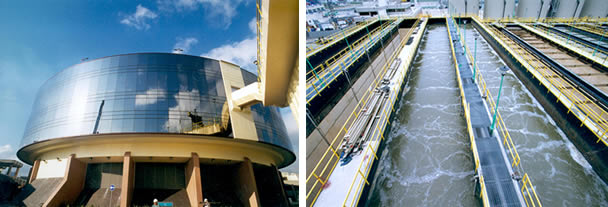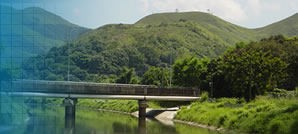In
2003, all major sewage treatment works performed satisfactorily,
meeting and very often achieving better than the licence requirement
imposed by the environmental authority. Various difficulties
were encountered and subsequently resolved, while new initiatives
were introduced to continuous improve the output and outcome
of our work. A few examples are highlighted below.
Stonecutters Island
Sewage Treatment Works
In 2003, our largest facility Stonecutters Island Sewage Treatment
Works treated close to 1.4 million cubic meters of sewage
a day, putting it amongst the world's largest operation of
its kind. Using Chemical Enhanced Primary Treatment (CEPT)
process, the SCISTW achieved an average BOD5 removal efficiency
of around 70% and TSS removal efficiency of around 80%, hugely
surpassing the designed values of 35% and 70% respectively.
By sustaining the highest standards of operation, DSD assured
the best possible environmental benefit for Victoria Harbour.
Shatin Sewage Treatment
Works
Against an increase of odour complaints, the works took a
number of measures to address the situation. This included
containment of the odour source by enclosures or covers, dosing
chemicals to prevent the formation and release of odour, treating
the malodorous gas before emission, and putting in place a
monitoring system to measure hydrogen sulphide at strategic
locations. Upon these efforts, the air quality in the neighbouring
areas improved and the number of odour complaint dropped.
The shortfall in treatment capacity remained
to be a challenge. Online sensors were installed to provide
instantaneous information on the condition of the reactor
tanks. With intensive effort in adjusting reactor conditions,
the effluent quality continued to improve in 2003, bringing
it in line with the effluent discharge licence conditions
by November. Construction of the long term improvement works
to provide the much needed capacity was in good progress,
with effluent treatment phase of Phase I due for completion
in 2004 and Phase II, in 2005.
Shek Wu Hui STW
To save energy, the High Volume and Low Volume Blower Systems
were connected up in 2003. Lower air flow is now applied to
reactor tanks at low effluent flow period, whereas full flow
is applied during peak flow period. It is observed that the
unit aeration cost is reduced from $0.158 to $0.138 per m3
of sewage treated, which is equivalent to $584,000/yr. Working
on this success and to provide further energy savings, we
will install a new LV blower by October 2004 funded under
Save and Invest Accounts. This will allow further flexibility
to match air supply with flow volume throughout the day, hence
achieving power economy.
Yuen Long STW
In 2003, the aged ceramic air diffusers in all aeration tanks
were replaced with more efficient membrane type air diffusers.
Less air supply is required from the air blowers due to improved
oxygen transfer efficiency. This improvement will result in
a $0.4M saving in electricity expense each year.
Tai Po Sewage Treatment
Works
Significant electricity was saved by channelling effluent
into a few reactor tanks during the low intake period at night
time. Energy savings was accomplished without affecting effluent
compliance. In seeking continuous improvement, an energy audit
was carried out in June 2003 with a view to identifying further
Energy Management Opportunities.
Mui Wo Sewage Treatment
Works
DSD conducted an energy audit in June 2003 joined by EMSD
engineers. The main purposes of the audit were:- (1) to identify
the major power consumption equipment and recommend feasible
energy management opportunity (EMO) with the energy saving
forecast; and (2) to apply EMO to improve the efficiency and
performance of the plant with the implementation of energy-saving
measures. The walk also served as a "train-the-trainer"
session where skills from EMSD in energy auditing could pass
on and multiply in DSD.
Sewerage works in urban
area
Construction and replacement of sewers in the busy urban area
poses a unique challenge to DSD. The mitigation of disruption
to traffic, air, noise and drainage nuisances is our prime
concern. Road openings are reduced to a minimum such as by
the use of trenchless methods. Hoardings are placed to separate
pedestrians from the work site. Stringent environmental controls
are enforced at the site to properly manage dust, odour, noise
and muddy drainage. Works duration is shortened to the minimum
possible. Communication channels are open to neighbours so
that grievances can be attended to and resolved immediately.

|
